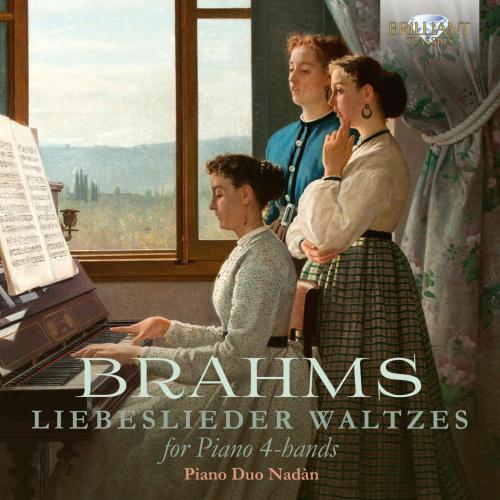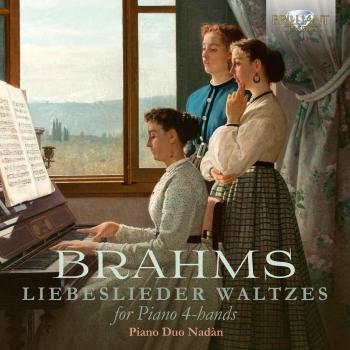
Brahms: Liebeslieder Waltzes for Piano 4-Hands Piano Duo Nadàn
Album info
Album-Release:
2022
HRA-Release:
27.05.2022
Label: Brilliant Classics
Genre: Classical
Subgenre: Instrumental
Artist: Piano Duo Nadàn
Composer: Johannes Brahms (1833-1897)
Album including Album cover Booklet (PDF)
- Johannes Brahms (1833 - 1897): Liebeslieder, Op. 52a:
- 1 Brahms: Liebeslieder, Op. 52a: I. Im Ländler-Tempo 01:06
- 2 Brahms: Liebeslieder, Op. 52a: II. 00:38
- 3 Brahms: Liebeslieder, Op. 52a: III. 01:25
- 4 Brahms: Liebeslieder, Op. 52a: IV. 00:39
- 5 Brahms: Liebeslieder, Op. 52a: V. 01:23
- 6 Brahms: Liebeslieder, Op. 52a: VI. 02:33
- 7 Brahms: Liebeslieder, Op. 52a: VII. 01:11
- 8 Brahms: Liebeslieder, Op. 52a: VIII. 01:14
- 9 Brahms: Liebeslieder, Op. 52a: IX. 02:21
- 10 Brahms: Liebeslieder, Op. 52a: X. 00:37
- 11 Brahms: Liebeslieder, Op. 52a: XI. 00:57
- 12 Brahms: Liebeslieder, Op. 52a: XII. 00:41
- 13 Brahms: Liebeslieder, Op. 52a: XIII. 00:42
- 14 Brahms: Liebeslieder, Op. 52a: XIV. 01:04
- 15 Brahms: Liebeslieder, Op. 52a: XV. 00:55
- 16 Brahms: Liebeslieder, Op. 52a: XVI. Lebhaft 01:02
- 17 Brahms: Liebeslieder, Op. 52a: XVII. Mit Ausdruck 01:47
- 18 Brahms: Liebeslieder, Op. 52a: XVIII. Lebhaft 01:33
- Neue Liebeslieder, Op. 65a:
- 19 Brahms: Neue Liebeslieder, Op. 65a: I. Lebhaft, doch nicht Schnell 00:42
- 20 Brahms: Neue Liebeslieder, Op. 65a: II. 01:19
- 21 Brahms: Neue Liebeslieder, Op. 65a: III. 01:08
- 22 Brahms: Neue Liebeslieder, Op. 65a: IV. 00:42
- 23 Brahms: Neue Liebeslieder, Op. 65a: V. 01:09
- 24 Brahms: Neue Liebeslieder, Op. 65a: VI. 00:48
- 25 Brahms: Neue Liebeslieder, Op. 65a: VII. Lebhaft 01:08
- 26 Brahms: Neue Liebeslieder, Op. 65a: VIII. Ruhig 01:37
- 27 Brahms: Neue Liebeslieder, Op. 65a: IX. 01:13
- 28 Brahms: Neue Liebeslieder, Op. 65a: X. 00:44
- 29 Brahms: Neue Liebeslieder, Op. 65a: XI. Lebhaft 00:40
- 30 Brahms: Neue Liebeslieder, Op. 65a: XII. Lebhaft 01:33
- 31 Brahms: Neue Liebeslieder, Op. 65a: XIII. Lebhaft 01:14
- 32 Brahms: Neue Liebeslieder, Op. 65a: XIV. Lebhaft 01:50
- 33 Brahms: Neue Liebeslieder, Op. 65a: XV. Zum Schluß. Ruhig, Andante 02:47
- Zigeunerlieder, Op. 103:
- 34 Brahms: Zigeunerlieder, Op. 103: I. Allegro agitato-Più Presto 01:19
- 35 Brahms: Zigeunerlieder, Op. 103: II. Allegro Molto 00:50
- 36 Brahms: Zigeunerlieder, Op. 103: III. Allegretto 01:20
- 37 Brahms: Zigeunerlieder, Op. 103: IV. Vivace Grazioso 01:03
- 38 Brahms: Zigeunerlieder, Op. 103: V. Allegro Giocoso 01:03
- 39 Brahms: Zigeunerlieder, Op. 103: VI. Vivace Grazioso 01:32
- 40 Brahms: Zigeunerlieder, Op. 103: VII. Andantino Grazioso 01:27
- 41 Brahms: Zigeunerlieder, Op. 103: VIII. Andante, Semplice 01:25
- 42 Brahms: Zigeunerlieder, Op. 103: IX. Allegro 01:42
- 43 Brahms: Zigeunerlieder, Op. 103: X. Andantino 02:57
- 44 Brahms: Zigeunerlieder, Op. 103: XI. Allegro Passionate 01:14
Info for Brahms: Liebeslieder Waltzes for Piano 4-Hands
Instrumental arrangements of Brahms at his most unbuttoned and relaxed, including a world premiere recording for this version of the Zigeunerlieder.
The influential critic Eduard Hanslick was shocked by the discovery that ‘Brahms the serious, the taciturn, the North German, the Protestant, the man who detests the world writes waltzes!’ In this regard he underestimated Brahms just as he did Liszt and Wagner, the composers of opera and symphonic poems whom he detested. Brahms always retained a connection with and affection for all forms of amateur music-making, and indeed had been a well-loved conductor of an amateur choral society, of the kind for which the Liebeslieder waltzes were written. The Liebeslieder-Walzer are a brilliant tribute to the musical tradition of the Habsburg capital, that tradition of popular dances that traced back its composed heritage to Schubert and later the Strauss dynasty (Brahms was inordinately fond of Strauss waltzes).
He composed them for a mixed vocal quartet (solo or choral) with piano accompaniment for four hands, according to a model already adopted by Schumann in several collections. In fact the first of the two sets was already designed for performance without voices, inspired by Brahms's somewhat awkward infatuation with Julie Schumann, and intended as a piano duo for the composer with Clara Schumann.
Brahms made the arrangements of both sets of Liebeslieder himself, and they proved a commercial hit for the publisher Simrock. Prevailed upon for a sequel, Brahms wrote the Zigeunerlieder (Gypsy Songs) in 1874, and in a more allusive, concise style, experimenting with form and producing a set of more unpredictable, changeable pieces. This time he left the piano-duo arrangement to a trusted colleague, Theodor Kirchner, who had already produced several similar transcriptions of his music.
As the Piano Duo Nadàn, sisters Nadia and Angela Tirino join the likes of the Labèques, the Önder sisters and Christina and Michelle Naughton on record. Having studied in Florence they now teach at the city’s Academy of Music. This is their second album for Brilliant Classics, after a collection of the piano duos (95647) by a contemporary and friend of Brahms, Heinrich von Herzogenberg, praised by La Nazione newspaper for its ‘fidelity and interpretative mastery’.
With his Liebeslieder-Waltzes Johannes Brahms (1833-1897) presented a beautiful tribute to the musical tradition of Vienna, the Habsburg capital, a tradition that, starting with the ländler, had taken shape in the waltzes of Schubert and later of the Strauss dynasty. Brahms himself had already composed a successful series of piano waltzes a few years earlier, published as Op. 39. Unlike the latter, the two series of Liebeslieder-Waltzes are intended for a mixed vocal quartet with piano accompaniment for four hands, the version of the Liebeslieder-Walzer presented here is an adaptation for piano four-hands by Brahms himself.
The 11 Zigeunerlieder are a good representation of Brahms in his last creative phase, as he seems to turn a last glance at the world of Hungarian folklore - the world to which his old partners such as Joseph Joachim and Eduard Reményi belonged.
The sisters Nadia and Angela Tirino have played together since childhood, and they share that intimate understanding, musical instinct and equality of partnership common to first-class sibling piano-duets. Having both studied at the conservatoire in Florence, they live and work there, teaching and performing, but also joining the jury of distinguished piano competitions around the world. Their recording for Brilliant Classics of works by Von Herzogenberg received excellent reviews in the international press.
Piano Duo Nadan:
Nadia Tirino, piano
Angela Tirino, piano
No biography found.
Booklet for Brahms: Liebeslieder Waltzes for Piano 4-Hands













